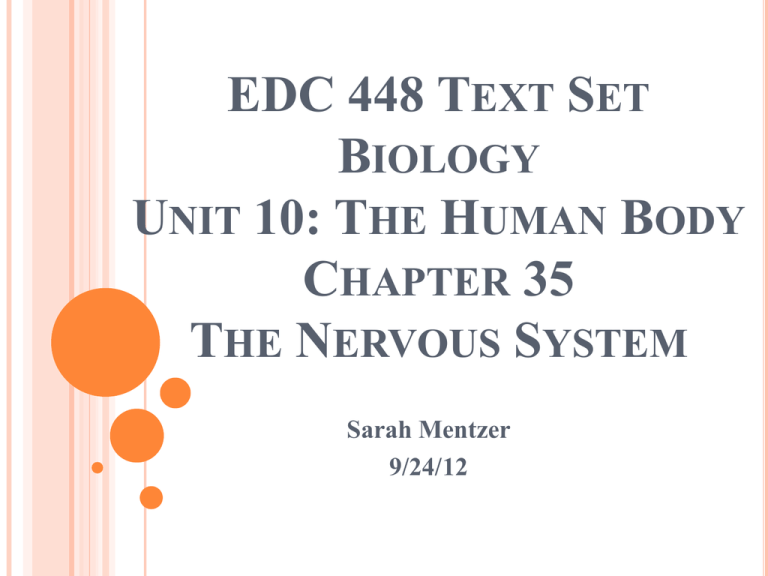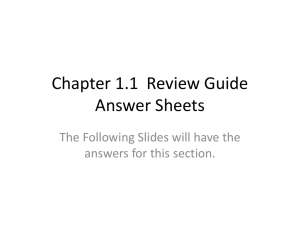
EDC 448 TEXT SET
BIOLOGY
UNIT 10: THE HUMAN BODY
CHAPTER 35
THE NERVOUS SYSTEM
Sarah Mentzer
9/24/12
GUIDING QUESTIONS
1.
2.
3.
Imagine you had to give up one of your senses for a day. Which
one would you choose and why?
What are the main differences between the somatic nervous
system and the autonomic nervous system? If you lost control of
one of these systems, which would be a more severe immediate
lose?
Do you think we have a clear understanding of how the brain is
connected to the mind and the emotions?
PRENTICE HALL BIOLOGY
Miller, Kenneth R., and Joseph Levine. Biology. Upper Saddle River, NJ: Pearson Prentice Hall, 2002. Print.
The textbook, Biology, is broken down into 10 Units, with 3-4 chapters in each unit. Each chapter contains
bolded vocabulary and key concepts that are summarized at the end of each chapter in the study guide.
There are plenty of graphics, photos and diagrams; along with experiments to relate the literature to the
students. The chapters are broken down into smaller sections so the information is not overwhelming. The
topics could be overly complex but with supportive scaffolding through teaching, the concepts could be
easily understood.
Quantitative Analysis of this text: The method I used to do the quantitative analysis for this text was the
Flesch-Kincaid method. I used a paragraph from types of tissue in the human body. The Flesch-Kincaid
Grade level assigned was 11. The Flesch-Kincaid Reading Ease score assigned was 43. Which means as far
as grade level it scored fairly high because the majority of high school students seem to be taking Biology in
either 9th or 10th grade, but the Reading ease score marks it as being of average difficulty. The text falls
right in the middle of difficult and easy. I think this text would be acceptable to teach younger grades. As
the teacher I would have to take into account they might need more support, scaffolding, from me in order to
understand these concepts.
For the Qualitative Analysis of this text as far as Levels of Meaning and Purpose, the information included is
fairly straight forward. It is a science text so there is minimal figurative language, and other than the
vocabulary involved I would not consider it extremely complex. The structure of the text is also fairly
straight forward it is very well organized clearly broken down into Units, Chapters, and Sections. I think the
text does require higher knowledge demands. The students are going to need some background knowledge
from general science classes to jump into the concepts in Biology. The vocabulary can be challenging and
students will probably need to be guided through some of the topics will be foreign knowledge to them.
“REALLY? THE BRAIN GETS REWIRED
IF ONE OF THE SENSES IS LOST.”
O'Connor, Anahad. "Really? The Brain Gets Rewired If One of the Senses Is Lost." The New York Times. N.p., 6 Aug. 2012. Web.
20 Sept. 2012. <http://well.blogs.nytimes.com/2012/08/06/really-the-brain-gets-rewired-if-one-of-the-senses-is-lost/>.
This is a New York Times article describing how when a sense is lost the brain gets rewired to compensate
for that lose. I love the idea of using this article as part of my text set because it takes the information that
students are learning in the classroom and relates it to research findings in the field. I think it is so important
to stay up to date on new develops in the research field to help inspire students to connect what we are
learning in the classroom to future career development.
For the qualitative analysis of this text as far as Levels of Meaning and Purpose, the information is straight
forward as they discuss the findings of recent research. They do not use figurative language or complex
meaning. The Structure of the article is well organized it is fairly short and to the point. The only set back
of this article is that it does require higher Knowledge Demands. The target audience for the NY times is not
9th and 10th graders, so the article is written for the mature adult reader. The vocabulary in the article is
fairly advanced, but many of the terms are covered in the chapter we are learning. I would not be
comfortable assigning this article for home reading because of the complex terminology, but I would assign
the reading at the beginning of class to create discussion about developments in the field and relate the
information to the senses which are covered in this chapter.
“PROBE THE BRAIN”
"PBS Teachers." PBS. PBS, 1 Oct. 2001. Web. 24 Sept. 2012. <http://www.pbs.org
This is a great interactive activity called “Probe the Brain”. Where it allows students to pin
different areas on the brain and it shows you the correlating movement in the body. They do
give a brief history of a Canadian brain surgeon who was responsible for mapping the brain’s
motor cortex. This interactive activity allows students to relive his exploration of the brain, by
letting them shock and observe.
For the qualitative analysis of this text, as far as Levels of Meaning and Purpose, the text is
very straightforward. They give a brief history, and the rest of the site is just the interactive
model. There is no figurative language and the meaning of the text is not complex. The
Structure of the site is well organized, there is not a lot of information on the site to find
distracting. The Knowledge Demands of the site are appropriate, the site is geared towards
students learning about the nervous system.
BRAIN FUNCTION, ANATOMY &
DIAGRAM
"Brain Function, Anatomy & Diagram | Body Maps." Brain Function, Anatomy & Diagram | Body Maps. N.p., n.d. Web. 24 Sept.
2012. <http://www.healthline.com/human-body-maps/brain>.
This site gives a 3-D Interactive Model of the Anatomy of the human brain. Allowing you to
view an image of the human brain from several different angles and depths. You can look at
the whole brain, a section of half the brain, and the structures of the inner brain. The model
allows students to pick a view of the brain, and then click on each part of the brain to explain
what structure they are viewing and what its function in the body would be.
For the qualitative analysis of this text, for Levels of Meaning and Purpose, the text is very
direct. They present the information and images clearly with no figurative language or hidden
meanings. The Structure of the site is very well organized. You are presented with several
different images on how to view the brain, starting with the outside structures and working
towards the inner structures. The Knowledge Demands to use this diagram are not complex,
they explain clearly each structure and even describe what the purpose is in the body. The site
is not geared specifically to 9th and 10th graders, but the information included would not be
overly complex for that age group.
“DESIGNER DRUGS: EFFECT ON BRAIN
CHEMISTRY ‘LIKE ECSTASY’”
"Designer Drugs: Effect on Brain Chemistry 'like Ecstasy'" BBC News. BBC, 14 Dec. 2011. Web. 24 Sept. 2012.
<http://www.bbc.co.uk/news/health-16185373>.
There is a big focus in this chapter on how drugs affect the nervous system. This article from BBC,
looks at the effects on brain chemistry from drugs like ecstasy. They look at the physical reaction that
the brain has after taking drugs like ecstasy and similar stimulates. I like the thought of using this
article as one of my text sets to show the students the connection between information they learn in
the classroom and other drug prevention programs and research happening in the real world.
For Levels of Meaning, the information in the article does not have hidden messages or use figurative
language. The Structure of the article is well organized and presented in a clear fashion. The
Knowledge Demands for this article would be considered high. The students would need some
background knowledge about drugs. The article is written for the mature adult reader so it may be
slightly complex for the average 9th or 10th grader to comprehend. The vocabulary in the article is
fairly advanced; they discuss some drugs that I’ve never heard of before so I wouldn’t expect my
students to have prior knowledge of those drugs either. Again this is not an article that I would assign
for home reading, but I think students would be fine to read it together in the classroom with support
if they don’t understand anything in the article
.
“HOW NERVES WORK.”
Freudenrich, Craig, PhD. "How Nerves Work." HowStuffWorks. N.p., n.d. Web. 24 Sept. 2012.
<http://science.howstuffworks.com/environmental/life/human-biology/nerve.htm>.
This is an excellent article that breaks down how nerves work in connection with the entire nervous system.
They go into great detail about the processes involved and use many of the same concepts and vocabulary
terminology used in the chapter. They have a bunch of simplified visual diagrams showing different parts of
the nervous system to help visual learners. The article may go too in depth for what we would be covering
in the classroom but I would still consider it a great reference tool.
For Levels of Meaning, the text in this article is very clearly stated. The information included would be
considered fairly complex just because of the content but the language is clearly stated. The structure of the
article is very well organized; it begins with the breakdown of different types of nerves and goes all the way
through nervous system disorders. I would not consider the Knowledge Demands for this article very high
because the information included parallels what we would be covering in the chapter closely, just with more
in depth detail. The vocabulary is geared towards students, and does not seem overwhelming.
“NEUROLOGY PICTURES”
"Curiosity." Discovery Channel. N.p., n.d. Web. 24 Sept. 2012. <http://dsc.discovery.com/tv-shows/curiosity/topics/neurologypictures.htm>.
The Discovery Channel has collected a variety of images that are related to neurology, ranging from real
brain surgery, to new developments in mice testing antidepressants in the neuroscience field, to photos from
the 1950s showing the first recording of a patients brain activity. The images are beautiful and help
demonstrate how complex and intricate the neurology field has become. Some of the images are fairly
graphic, and may be disturbing to some of the students.
For Levels of Meaning, there is not a lot of actual text involved except for a brief summary of explaining
each image. The text that is included is brief and to the point. The Structure of the images is not well
organized. They jump from past to present, to images of surgery, to images of mice. It does keep the
viewer’s attention because you don’t know to expect next. The Knowledge Demands for this link would not
be considered high, you would not need prior knowledge to enjoy viewing the image and hearing about their
history.
QUIZ WHAT DO YOU KNOW ABOUT
THE BRAIN?
"Curiosity." Curiosity. N.p., n.d. Web. 24 Sept. 2012. <http://curiosity.discovery.com/topic/cognitive-neuroscience/brainquiz.htm>.
The Discovery Channel created this ten question quiz, “What do you know about the brain” This could be a
fun activity to use for the students in the lesson plan. It has more random facts about the brain than it does
closely follow the information in the chapter, but I still think it could be a fun activity for them to do. We
could see who was able to get the most correct out of the class.
For Levels of Meaning, there is not a lot of text involved in the quiz, except for the actual questions and the
quick responses if you answered incorrectly. The information that is provided is concise and to the point.
The Structure of the quiz, is fairly well organized. The questions do not really follow any precise order
except for they are all questions related to the brain and nervous system. The Knowledge Demands for this
quiz would be considered very high if the students were expected to get all of the answers correct. I would
not expect my students to get all of the answers correct, because I didn’t even get all of the answers correct
when I took the quiz. I think the students could just use this quiz to test what they knew, and use it to start
discussion.
5 ADVANCES IN BRAIN SCIENCE?
Scheve, Tom. "Curiosity." Discovery Channel. N.p., n.d. Web. 24 Sept. 2012. <http://dsc.discovery.com/tvshows/curiosity/topics/5-ways-science-studying-brain.htm>.
This is an article from the discovery channel that covers 5 new advances in brain science. It discusses all the
advances in technologies that we have for imaging the brain and the nervous system, as well as our ability to
implant electrodes that can record signal impulses, and how psychologist can now use Intelligence Studies to
study the brain. This article would be very interesting to use as part of my text set, because it shows students
how scientists are connecting technology to science to make new advances in the field.
The Levels of Meaning for this text are very clearly written. The language used is appropriate for a student
audience. The Structure of the article is clearly organized, and it flows from each topic with an easy
description of each new advance in brain science. The Knowledge Demand for this article is fairly low.
Students would need limited prior knowledge to understand the advances that they are discussing, they give
a clear and simple description of each advance in science in the article.
UNDERSTANDING BRAIN SCIENCE
Understanding Brain Science. Perf. Dr Siegel. The Discovery Channel. N.p., n.d. Web. 24 Sept. 2012. <http://dsc.discovery.com/tvshows/curiosity/topics/d-siegel-understanding-brain-science.htm>.
This is a 2:33 video on understanding the science of the brain. The topic is addressed by Dr. Siegel, The
Executive Direction of the Mindsight Institute. It discusses how far science has come in understanding the
brain and nervous system, and how much we still do not understand. The video presents several questions
for students to think about concerning how much we still have to learn about the brain/mind connection.
For Levels of Meaning, the information provided in the video is fairly complex only because of the concepts
they are discussing. He is talking about scientific discoveries that have yet to be made. I think the video is
appropriate for a student audience because even though the information is dense, it will really get them
thinking. The Structure of the video is well organized, he clearly states the advances that have been made in
the field, and then addresses what we still need to discover. The Knowledge Demands for this video are
fairly low. The students would not need a lot of prior knowledge to be able to watch the video and think
about the questions being presented.





